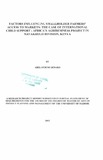| dc.description.abstract | The Strategy to Revitalize Agriculture, Kenya Vision 2030, Comprehensive
African Agricultural Development Program and Alliance for Green Revolution in
Africa have underscored the importance of increasing agricultural productivity in the
fight against poverty. The Kenya government identifies smallholder agriculture as the
major sub-sector for realizing accelerated annual economic growth rate to attain the
country's Vision 2030. Commercializing smallholder agriculture is critical to achieve
this growth. Smallholder farmers' access to markets and agricultural support services
has been a major concern for Kenyan policy makers since independence. This study
undertook to assess the factors that influence smallholder famers' access to markets in
Navakholo division. The purpose of this study was to assess the factors that influence
smallholder farmers' access to markets in Navakholo division. Objectives of the study
included; to establish the extent to which technical inputs affects smallholder farmers
access to markets, to examine how physical infrastructure affects smallholder farmers
on access to markets, to assess the extent to which technical institutions affects
smallholder farmers' access to markets and to establish the extent to which technical
information affects smallholder farmers' access to markets in Navakholo division.
The study was guided by the induced innovation theory and a conceptual framework
showing the relationship between independent variables and the dependent variable.
The study used descriptive survey design. The study used a sample size of 196
farmers drawn from target population of 416 farmers. A mixture of probability and
non-probability sampling methods were employed to arrive at the respondents for
interviews. Quantitative data was collected through use of questionnaire while
qualitative data was collected through interview guides administered to key
informants. The researcher and 12 research assistants personally administered the
questionnaires to the respondents. Data was analyzed using descriptive statistics with
the aid of Statistical Package for Social Sciences and Microsoft S Excel while data
presentation was done through use of tables, frequencies, percentages, modes and
mean. The study found that very few smallholder farmers in the division uses
technical inputs in their farms due to high input costs. Majority of smallholder
farmers 137(71%), do not apply fertilizer consistently while 169(86%) of farmers do
not use certified seeds. This results into low yield and limits farmers' access to
markets. Majority of farmers 194(99%) sell their produce at the farm gate
immediately after harvesting because of poor physical infrastructures especially
access roads which results into increased cost of transporting farm inputs and farm
produce to the market. The study also found that most of the respondents 168(86%)
would join farmer groups for social benefits rather than economic gains. The study
further revealed that 127(65%) of farmers have never had contact with reliable source
of technical information. The study concluded that the existence of huge market
presented by Kakamega town did not stimulate agribusiness market among
smallholder farmers in the Division. The study recommends that development
agencies and policy makers should strengthen farmer groups as vessels for social and
economic development and provide adequate and reliable market information to the
farmers. The study suggests that further research should be undertaken on the
influence of Kakamega town on smallholder agribusiness practices in Navakholo
division. | en_US |

